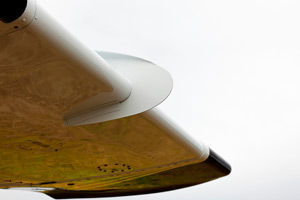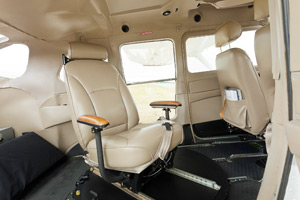Mark II Cessna 206: The ultimate family truckster
The Rolls-royce of Cessna 206s
What was the first turbine single certified in America? Most of us would say the Cessna Caravan, which debuted in 1985. But no. Under a supplemental type certificate (STC) Soloy Aviation Solutions of Olympia, Washington, began modifying Cessna 206s with reverse-flow 417-shaft-horsepower Rolls-Royce/Allison 250-C2 turboshaft engines in 1983. Soloy called this modification the “Mark I” model, and it came fitted with a Soloy-designed and -manufactured propeller-reduction gearbox. In all, 85 Mark I Cessna 206 conversions were built over the years. Soloy’s Mark I kit applies to Cessna 206G and -H models built from 1977 to the present.
In October 2008 Soloy came up with an improved turbine 206 mod: the Mark II. The STC applies to 1998-2004 Cessna 206H and turbo 206H models, and this fire-breather comes with a more powerful Rolls-Royce 250-B17F—one with a direct-flow induction system and a Rolls-Royce gearbox. This setup provides several advantages over the Mark I. First, there’s the drag reduction realized by the elimination of the Mark I’s dual engine air intake scoops; the Mark II uses a single intake right below the propeller spinner. The new gearbox gives the Mark II beta and propeller reverse, which wasn’t available in the earlier model. And the -B17F engine has higher turbine outlet temperature (TOT) limits, which let it produce more power at altitude—and gives the Mark II better hot-and-high takeoff performance.
Like the Mark I’s engine, the Mark II’s takeoff power is 417 shaft horsepower. But the new engine is rated at 510 thermodynamic horsepower, which gives the airplane its performance edge when conditions rise above standard (the Mark I’s -C2 engine is rated at 448 thermodynamic horsepower). Maximum continuous power for the -B17F is 322 shaft horsepower.

September 2011
Turbine Pilot Contents
- Turbine Intro: Swapping Avgas for Jet-A: Special section for the turbine inclined.
- The Ultimate Family Truckster: Soloy bolts a 417-shaft-horsepower turboprop to the venerable Cessna 206.
- (Not) Straight-In: Approaches in a different way.
- Turbine Profile: Stuart Woods: No jet, no book tour.
Power to spare
Soloy’s Mark II conversion transforms the already utilitarian Cessna 206 into a high-performance platform capable of many specialty missions. Soloy CEO David A. Stauffer touts the Mark II as a flying SUV that can take big loads into small, unimproved strips, making trips to those remote vacation spots with short runways a breeze. Customers also rank the Rolls’ reliability and 3,500-hour recommended time between overhaul (TBO) as other big draws. That, plus the 100-plus horsepower advantage over the standard airplane (206Hs come with 300-horsepower Lycoming IO-540s; turbocharged T206Hs have 310-horsepower Lycoming TIO-540 engines).
 It all adds up to an airplane with a 1,650-fpm maximum rate of climb and cruise speeds in the 180-KTAS range. Just remember that those cruise speeds come with caveats. You’ll only realize higher cruise speeds at altitudes above 14,000 feet, where supplemental oxygen will be required, where fuel burns drop to some 25 gph, and where ranges can extend as far as 950-plus nm (assuming you’re flying at maximum-range power settings and you’re fitted out with Soloy’s 54-gallon auxiliary fuel tank option).
It all adds up to an airplane with a 1,650-fpm maximum rate of climb and cruise speeds in the 180-KTAS range. Just remember that those cruise speeds come with caveats. You’ll only realize higher cruise speeds at altitudes above 14,000 feet, where supplemental oxygen will be required, where fuel burns drop to some 25 gph, and where ranges can extend as far as 950-plus nm (assuming you’re flying at maximum-range power settings and you’re fitted out with Soloy’s 54-gallon auxiliary fuel tank option).
Where customers usually fly—down low—turbine-engine fuel burns soar and range is consequently reduced. At 4,000 feet and standard conditions, for example, the Mark II set for max cruise flies at 152 KTAS, burns 29 gph, and can travel a mere 320 nm before dipping into fuel reserves. Of course, you can always dial back the propeller to save gas, or add one of the optional Flint-Aero fuel tanks (30 or 52 gallons) to the airplane’s standard, 87-gallon fuel system to boost range. But there’s no free lunch. Extra fuel means less payload.
Even so, customers don’t seem to mind. They want turbine power in their trusted 206s, period—in much the same way that a niche of Bonanza aficionados has opted for Rolls-Royce 250-B17 power using Tradewind Turbines’ modification. A modification, by the way, that has its origin as a Soloy STC.


Amphib, jump, and law enforcement
Of the Mark IIs currently in service, two have been amphibious conversions. This involves installing a set of Wipaire 3450 amphibious floats ($140,000); a right-front door is also available from Soloy (stock 206s come with single, pilot-side doors).
A skydiving modification ($25,000) is also available for the Mark II. This gives you two additional steps on the right landing gear strut and hand grips above the doors. So far, three skydiving Mark IIs are in service, with another in completion at Soloy’s factory. All of these airplanes are destined for service in Europe, where another option—a $35,000, five-blade, composite propeller manufactured by MT Propeller—is popular because of its lower noise footprint.
The law enforcement version—Soloy calls it the “Sentinel”—includes a specially designed, rotating rear observer seat, a large window on the left side of the aft cabin, and a wing mount for an articulating infrared camera turret. The idea here is to fly at high altitude, dial back the power, take advantage of the lower fuel burn, and loiter for hours while hunting for bad guys.

Flight impressions
 Soloy Chief Pilot Paul Haggland showed me the ropes on a newly converted Sentinel. Approaching the airplane, several things stand out. Yes, there’s the big, aft-fuselage window, but also readily apparent is the larger, beefier vertical stabilizer, designed to handle the higher torque and other stresses associated with installing a turbine engine. So is the 206’s elongated snout, which actually makes the airplane much more streamlined, and looks sexier than a plain-Jane 206. The 250-B17 weighs just 190 pounds, so it must be mounted farther forward than the much heavier Lycoming in order for the Mark II’s center of gravity to stay where it’s supposed to. Vortex generators mounted on the wing leading edges further remind you that this is no run-of-the-mill 206. The vortex generators are there to preserve airflow over the wing and ailerons at high angles of attack. Soloy says that though the airplane may be in a stalled condition, the ailerons remain effective thanks to the vortex generators.
Soloy Chief Pilot Paul Haggland showed me the ropes on a newly converted Sentinel. Approaching the airplane, several things stand out. Yes, there’s the big, aft-fuselage window, but also readily apparent is the larger, beefier vertical stabilizer, designed to handle the higher torque and other stresses associated with installing a turbine engine. So is the 206’s elongated snout, which actually makes the airplane much more streamlined, and looks sexier than a plain-Jane 206. The 250-B17 weighs just 190 pounds, so it must be mounted farther forward than the much heavier Lycoming in order for the Mark II’s center of gravity to stay where it’s supposed to. Vortex generators mounted on the wing leading edges further remind you that this is no run-of-the-mill 206. The vortex generators are there to preserve airflow over the wing and ailerons at high angles of attack. Soloy says that though the airplane may be in a stalled condition, the ailerons remain effective thanks to the vortex generators.
Coming to grips with the airplane’s power lever took some time. It’s not a regular, push-pull control, although it does work that way within its two functions. A rotating collar identifies the lever’s ground (GND) and flight idle/beta (FLT/BETA) modes. To start, you flip the start switch and keep the lever in GND, which can also be used for taxiing—just push and pull to add or reduce power. But if you want to slow down by increasing the propeller blade angle, you push in slightly while in GND mode, then rotate the lever to the right. Now you’re in FLT/BETA’s flight idle mode. Pull back now, and you can go into propeller reverse. Push forward, and power is added.

Which is just what we did for the takeoff, which was impressive. With 10 degrees of flap, three aboard, and full fuel, the ship was off the ground at 45 knots and soon climbing away at 1,900 fpm and 100 KIAS, the windshield full of sky. The Pacific Northwest is a picturesque place to fly, with plenty of streams, coves, inlets, foothills, and mountains—all a short flight away. We flew up to Seattle, along the ridges east of Olympia, and even arranged a tour around Seattle’s Space Needle.
At 5,000 feet it was time to see what a typical cruise mission would show. On this 11-degree Celsius day, with the power set at 60 psi (like the Pilatus PC–12, the Mark II displays power measured in psi rather than torque), our speed was just below the 206’s 150 KIAS redline, and true airspeed worked out to 163 knots. The fuel burn was 156 pph, or about 23 gph. That’s about six or seven gph more than the stock 206’s Lycoming would burn, but again, for customers that’s not the point. They need the performance.
 Landings were straightforward, so if you can land a straight 206, you can land a Soloy Mark II. With the full 40 degrees of flap deflection we touched down at approximately 60 knots. Reverse thrust guarantees you’ll make that first turnoff.
Landings were straightforward, so if you can land a straight 206, you can land a Soloy Mark II. With the full 40 degrees of flap deflection we touched down at approximately 60 knots. Reverse thrust guarantees you’ll make that first turnoff.
For those looking to move up to a turboprop single, the Soloy Mark II can make a lot of sense. At $650,000 for the basic conversion—this assumes you bring Soloy your own 206—you convert your airplane for a comparatively low price. On the other hand, Soloy can find an older 206H (they have been built since 1998) for you and then convert it, making the price as low as $950,000.
That’s a lot of money, but your other options are the much larger and more expensive Cessna Caravan, Quest Kodiak, and Pilatus Porter. Turboprop singles like the Piper Meridian, Pilatus PC–12, and Daher-Socata TBM 850 are tailored for missions incompatible with the Cessna 206’s design goals. So for the diehard 206 enthusiast the Soloy Mark II may be the only game in town. It occupies a niche—between piston single and turboprop single—that perhaps deserves a closer look by the industry. Maybe that’s why Soloy says Cessna once looked at marketing the Mark II as a logical step on the way to Caravan ownership.
Email the author at [email protected].




